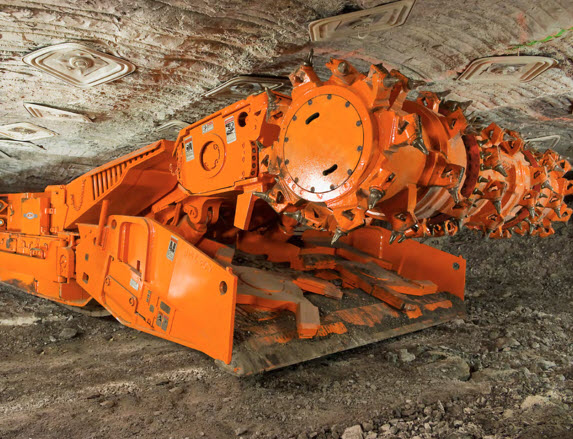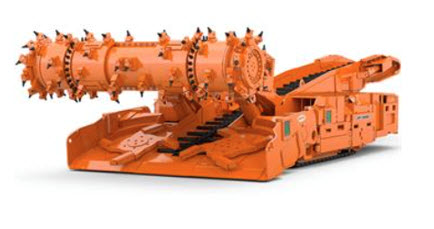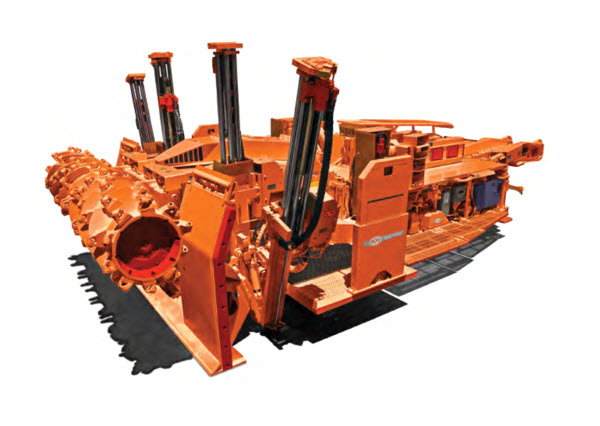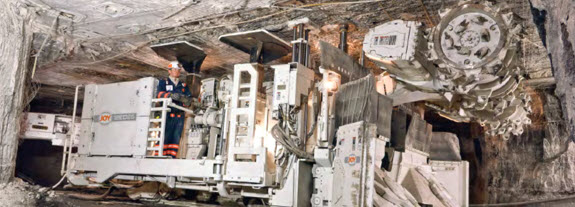5.3.1: The Continuous Mining Machine
A picture is worth a thousand words… so, let’s look at the front of a continuous miner. The cutting drum is about 2’ in diameter and perhaps 12’ wide. It is laced with carbide cutting bits, and the drum rotates at about 1 revolution per second. The cutting head is sumped into the top of the seam, and then the drum is pulled down, which is known as shearing. The sump and shear is completed in well under a minute and then repeated. The cut coal drops to the floor, where it is scooped into the belly of the machine. Look at the base of the machine – it sort of resembles a dustpan. There are two gathering arms, which move to pull the cut coal into the center of the machine.
Let’s look at the next picture to understand what happens to the coal.
Here you can see it more clearly. The gathering arms pull the coal onto a chain conveyor, which runs the length of the machine. The chain conveyor consists of a metal trough and metal flight bars that are attached to a chain. The flight bars, which are painted black in this picture, are pulled along the metal “pan,” or trough, by the chain. In this manner, the mined material is conveyed to the rear of the machine. The rear of the machine is known as the tail or tailpiece, and it can swing over a limited arc. The tailpiece is positioned over a waiting shuttle car, and the mined coal is fed into the shuttle car. The continuous miner will continue advancing forward with the sump-shear cycles until there is a reason to stop the advance. In U.S. coal mines, the forward advance is limited by a few factors: the need to ventilate the face to maintain safe methane levels and the need to install roof bolts to prevent roof failure. Further, by law, no miners can work under unsupported roof, which will limit the amount of advance. Once the maximum advance has been achieved, the machine will be trammed back out of the cut and moved to a new face.
All right, let’s stop and catch our breath! What have we accomplished with this innovation known as the continuous miner? We’ve replaced drilling, kerf cutting, blasting, and loading with one machine, thereby reducing the number of pieces of equipment, the number of miners, and importantly, the delays. We’ve achieved a remarkable gain in both production and productivity. So much so that conventional mining of coal is no longer practiced in this country. Of course, when you make these improvements, you then expose the next “weakest link” in the system. Based on what we’ve talked about, you probably have an inkling of the weak links. Take a guess!
Many of you have probably zeroed in on the shuttle car -- when the shuttle car is filled it trams to the section dump point and another shuttle car maneuvers into position. In the time that it takes for the full car to leave, and the waiting car to maneuver into position, the continuous miner is idled. That’s a delay that is going to adversely impact our “numbers”, i.e., production and productivity. We’re going to talk more about these haulage bottlenecks shortly, but as it turns out, this is a tough one to fix. There is another weak link, which some of you have undoubtedly spotted: the need to limit the continuous miner’s advance so that the roof can be bolted and ventilation can be extended.
Allow me to introduce you to the Miner-Bolter. It took a number of years to work out the kinks, but today these machines work well. There are different configurations, but the principle is the same: incorporate the bolter into the miner. A bolter operator stands on the platform immediately behind the bolter carriage on both sides of the machine. While the cutting drum is cutting coal, the bolter operators are drilling holes and installing bolts. There is a linked platform to allow the bolters to remain stationary while the cutting head is advancing forward.
Hydraulic canopies are essential to protect the bolter operators while they are drilling and bolting. The canopies are not extended in this picture, but in the next photo they are, giving you a clearer view.
Typically, there will be a ventilation tube, on the order of 24” in diameter, hung near the roof against the side rib. This tubing will be extended as the continuous miner advances forward, providing the air needed to sweep the face and remove dust and gas.
Although remarkable gains have been achieved, there remains the weak link with the shuttle cars. In fact, there are a couple of options that can be considered. Before taking up this topic, however, I want to say a few more things about these continuous miners.



